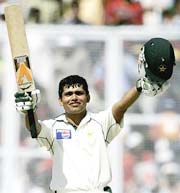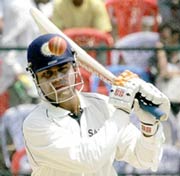THERE are men -- and knocks, and attitudes -- that define cricketing contests.
Curiously, at the end of the three Test series between India and Pakistan, I find myself flashing back to December 7, 2003.
Remember the day? The first of a four-Test series, India in Australia and very much the underdogs; Australia in the first innings 323 all out; rain interruptions, a juiced-up pitch; a superb but short-lived cameo from Sehwag; Rahul Dravid gone for 1 and continuing his miserable run on Australian soil; Tendulkar LBW Jason Gillespie, or was it LBW Steve Bucknor; India in some strife at 62/3 in 23 overs.
 And then Saurav Ganguly -- target, before the series, of much hard talk by the Aussies -- walked out. When he returned to the pavilion, India was 329/6 in the 95th over; his personal contribution to that total was 144, off just 196 deliveries.
And then Saurav Ganguly -- target, before the series, of much hard talk by the Aussies -- walked out. When he returned to the pavilion, India was 329/6 in the 95th over; his personal contribution to that total was 144, off just 196 deliveries.
It was glorious batting -- evading the short stuff, and there was plenty of it, with absolute confidence; driving like a dream through the off side despite skipper Steve Waugh manufacturing field placings to deny him runs there; playing the occasional pull and whipped drive off his hips just to tell bowlers pitching short who was boss.
That knock set up the series; it signaled to the Indians in the dressing room that it was possible to counter the Aussies, to take the attack to the opposition; equally, it signaled to the home team that the 'underdogs' had teeth, they could -- and would -- bite back.
What Ganguly did for India in Brisbane that rainy December day two years ago, the unheralded Kamran Akmal did for Pakistan at Mohali in the first Test of this series.
When Asim Kamal was 6th out, Pakistan was on 243/6 in the second innings -- just 39 runs ahead of India, and staring at defeat. At the crease was Abdul Razzaq, who had in the first innings played with shocking irresponsibility.
Akmal walked out, and took charge -- of the situation, the bowlers, and of his partner; he played with an assurance unlooked for in one so young; his 109 off 154 balls signaled to his mates that this Indian attack could be tamed; his defiance signaled to an Indian side looking for a romp that they were in reality in for the fight of their lives.
 When picking turning points in this series, the Kamran Akmal knock in the second innings at Mohali, and his fighting partnership with a reformed Razzaq, thus looms as the most significant.
When picking turning points in this series, the Kamran Akmal knock in the second innings at Mohali, and his fighting partnership with a reformed Razzaq, thus looms as the most significant.
It's one of those cruel tricks Fate plays, that the Ganguly of Australian vintage was reduced, in the final innings of this series, to standing at the crease for long heartbeats after his stumps had been disarrayed, unable to comprehend that yet again, he had lost his wicket when his team could ill afford it.
IN the first innings of the first Test at Mohali, India was cruising at 334/3 in the 81st over, when Virender Sewhag got out. The remaining seven wickets managed to last just under 67 overs, and scored 182 runs between them.
In the first innings of the third Test in Bangalore, Sewhag was fourth out, for 201 out of a team score of 337, in the 83rd over; the remaining six wickets managed 112 runs in 45.2 overs.
When Sehwag was unfortunately run out in the second innings, India had made 87 in just 23.4 overs; the remaining 9 wickets added 127 off 66.2 overs -- and this, mainly because Anil Kumble scored a fluent 37 off 52 deliveries.
Take away Kumble's contribution, and eight post-Sehwag wickets -- Gambhir, Dravid, Tendulkar, Ganguly among them -- managed 90 runs off 346 deliveries.
 India through the nineties was a one-man team, and his name was Sachin Tendulkar; India in this decade is rapidly reverting to a one-man team -- replace Sachin with Sehwag, and we are right back where we started.
India through the nineties was a one-man team, and his name was Sachin Tendulkar; India in this decade is rapidly reverting to a one-man team -- replace Sachin with Sehwag, and we are right back where we started.
In a column in July 2002, when I suggested that Sehwag should open for India in Tests, I remember the sniggering emails that piece triggered -- the guy has no footwork; his approach is not good at the top of the order; he is suspect outside his off stump; he is vulnerable to the short ball
Sehwag has proved his point. But the larger point, of what a player like him does at the top of the order, is in shambles. The thinking then was, his belligerence will serve to put bowlers and fielding captains on the defensive; that frees up the famed middle order to come out and stick the boot in.
Reality is the reverse. Yes, Sehwag puts the opposition on the defensive -- and the last day of play in this Test series produced a classic example. The first hour had been survived; Sami had been blunted; Razzaq had been reduced to the pedestrian; Inzy had just one throw of the dice left and he threw it, when he got Danish Kaneria to the bowling crease.
In the leg spinner's first over, Sehwag took a couple of deliveries to get a feel; to the third ball, flighted around off, the batsman stuck a foot down the track, got under it, and blasted it with terminal velocity back over the bowler's head.
An over later, Inzy and Kaneria decided to throw down the challenge. Mid off was pushed to long off, the invitation was for the batsman to try and hit with the turn. Kaneria tossed a leg break up outside off and thwack, it was carted a few feet over the fielder at long off.
The camera panned to Inzy who slowly sunk down on his haunches, head in hands. That moment put the match situation in perspective -- with that shot, Sehwag had signaled that he was game to take on the challenge, not just of a spread field but of chasing 353 on the final day. And Inzy very clearly had realized that the batsman confronting him was perfectly capable of pulling it off.
In his post-match summation, Saurav Ganguly suggested that India lost the match by being overly defensive after lunch. Sorry, Saurav -- the team lost the Test twice. First, on the evening of the fourth day; then again about 30 minutes before lunch on the final day, when Razzaq's throw from mid off hit middle stump with Sehwag nowhere in the frame.
The fourth day factor is easily explained: the team strategy was half-smart, to say the least. The strategy seemed to be, it is up to Pakistan to do all the heavy lifting; we will sit on the fence, till Inzy declares, whenever that is; and then we will play out time, draw this Test, and win the series 1-0.
Thus, within the first ten overs, every fielder had been pushed into a defensive position; singles were there for the taking; and though at times there were four men patrolling the boundary to a concentrated outside-leg attack, there were still enough gaps to find the fence when the bowlers erred in line.
Consider this: With Kumble and Sachin bowling in tandem for the most part, with both going around the wicket to six, at times seven men on the on side, Younis Khan managed to score 46 of his 84 runs on that side of the wicket, with 6 fours and as many as 24 singles; Inzy to the same bowling and field managed 26 of 31 on the leg side with three fours and 14 singles.
Time and again, you heard commentators on TV, when discussing the spread fields, saying 'Ganguly won't mind the singles, he is basically intent on ensuring that Pakistan doesn't get the big boundaries and pile up too many runs'.
Maybe Ganguly should have minded the singles -- there were 87 of them in the Pak second innings; those singles meant the bowlers couldn't settle into any kind of rhythm against any one batsman; they kept the board ticking over constantly, painlessly; they took the pressure off the batsmen, who could now afford to wait for the bad ball to club, and transferred it to the bowlers, who found runs being leeched off them even when they bowled good deliveries.
At no point in the Pakistan second innings did the fielding side try to exert pressure on the batsmen. Younis Khan walked in at the fall of Afridi's wicket, and found a spread out field confronting him; Inzy walked in after Yasser Hameed's dismissal, and had to shade his eyes with his hand to spot the fielders deep in the outfield.
Contrast that with Pakistan's effort in the Indian second innings: Sehwag got out, and Dravid walked in -- the man, mind, who had produced two flawless centuries in the previous game -- and found himself surrounded by slip, gully, silly point, and a short square leg.
A batsman of Sachin's class had first three, then four around the bat on the off side alone -- this, to a spinner like Arshad Khan, who has for five years not been able to find a place in the Pakistan Test side.
India 'didn't mind the singles' when Pakistan batted, because it had already played out the Test in its mind: Never mind whatever Pakistan gets, we will see if Sehwag can get us there, otherwise we will simply shut shop and draw the game and take the series.
And that is how India played the game. 11 overs were bowled between Sewhag's dismissal and lunch on day five; two batsmen -- Gambhir, who by then was stroking fluently, and Dravid, who in the previous Test had for the second time in his career hit hundreds in each innings to win Man of the Match -- managed just 15 runs between them. Four of those runs were the result of an edge not fielded at slip; four more were byes to fine leg when the bowler strayed in line.
Those 11 overs gave Inzy and his bowler's space -- first, to get their bearings after the Sehwag assault, and then to go on the attack.
India abdicated. For over after over, bowlers wheeled away with first six, then seven, then eight men around the bat. Check that field out in your mind -- 7 around the bat plus keeper and bowler is 9 fielders who are in no position to catch mishits, or to stop singles being taken at will.
Gambhir and Sehwag between them took 24 singles; they rotated strike and, until that run out, they kept the bowlers and fielders unsettled. The other 9 batsmen between them managed a grand total of 17 singles, to fields where there was a single for the asking with every firm push -- against which, they played out 328 dot balls between them.
Why? There is no explanation in sight. We lost because we got too defensive, says Ganguly; ditto, says Kumble in his column; ditto, say other members of the team in their columns and TV interviews.
Heck, we know that -- when batsmen of the caliber and experience of Tendulkar and Laxman play out a period of 52 deliveries without a single run going on the board, we who watched knew the play was defensive.
The question is, why did the team decide to down the shutters the moment -- no, not after lunch -- Sehwag was dismissed?
Is that, finally, no more, no less than a collective admission that Sehwag is the only batsman in this side with the nous to play the bowling on merit?






